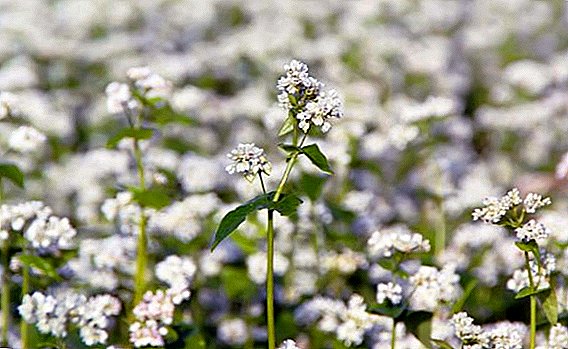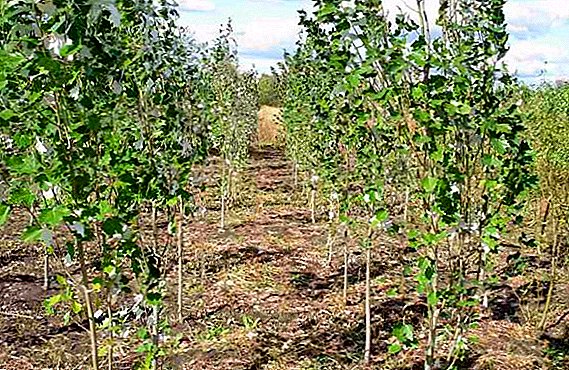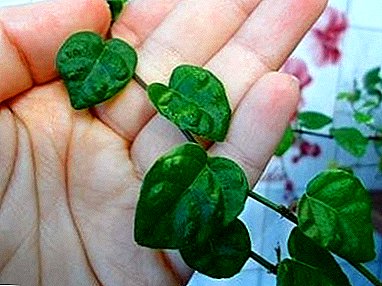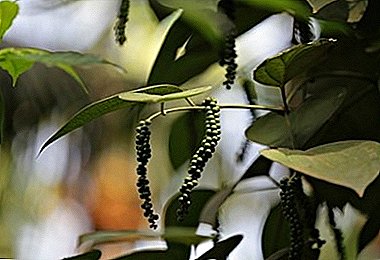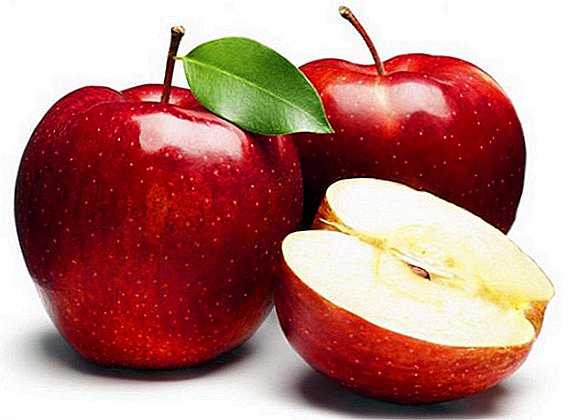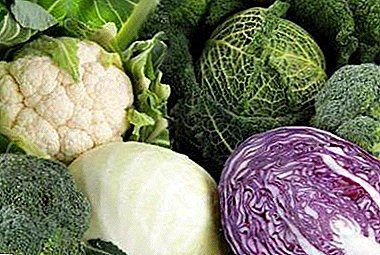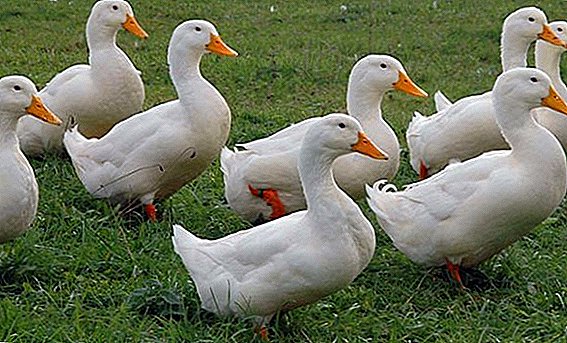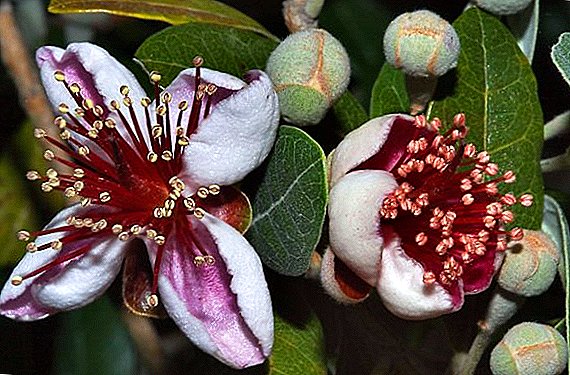 Feijoa, or Akka, is an exotic plant that is only gaining popularity, but many gardeners already grow it in their greenhouses. In this article we will get to know what kind of plant it is, how to plant it and grow feijoa by yourself.
Feijoa, or Akka, is an exotic plant that is only gaining popularity, but many gardeners already grow it in their greenhouses. In this article we will get to know what kind of plant it is, how to plant it and grow feijoa by yourself.
Description
Feijoa is an evergreen plant, the birthplace of which are subtropics of South America. In nature, it grows like a shrub or a small tree with a spreading thick crown. Its height is from 3 to 5 m. It has dense elliptical leaves, which are covered with a shiny film from above, and from the bottom - with small hairs that emit scent. Flowering tree begins in May and lasts 2 months. Flowers with a diameter of about 40 mm have white petals and bright pink stamens. During flowering, inflorescences are collected from 3 to 6 flowers.
Important! To obtain a crop at home, pollination of flowers should be carried out independently.
The fruits of this plant are berries of dark green color, with a wax-like bloom, reaching a length of about 6 cm and a width of about 4 cm. Often, the weight of berries ranges from 30 to 50 g, but sometimes you can find a fruit weighing 120 g. the fruit is dense, with a sour taste, the smell of her strawberry-pineapple. Maturation falls in the middle of autumn.
Growing conditions
Since feijoa is a specific plant, it also needs appropriate conditions for cultivation, both indoors and in open ground.
Climate
As already mentioned, feijoa is a subtropical tree, but despite the perennial efforts and some successes of breeders in adapting it to a cooler and arid climate, feijoa still needs high humidity and heat - that is, conditions that are characteristic of its native climate. Therefore, most often in open ground it is grown in warmer and more humid regions, such as the Crimea, Georgia, the south of the Krasnodar Territory of Russia, in some regions of Uzbekistan and Azerbaijan.
In our area, people have already learned how to grow kiwi, medlar, luffa, papaya, persimmon, melodria, momordiku, zizifus, pineapple.The plant is relatively frost resistant, able to withstand up to -10 ° C, but if the temperature drops below, the entire aboveground part of the feijoa freezes and the plant can recover only from root shoots. Therefore, it is recommended to plant a tree in an open ground in a continental climate only if if the plant is well seasoned.

Did you know? The first feijoa tree was introduced to our country in 1900.
Lighting
Feijoa refers to light-loving cultures. Therefore, when planting a tree in open ground, you need to take this into account and plant it. in the open area, and if you are going to plant it near the building, it is better to place it on the south side. Adult feijoa and seedlings that are grown indoors should be placed on the southern window-sills, and in the winter they need additional lighting. To do this, you can install one fluorescent lamp at 20 W near the plant. If you have the opportunity, additional light can be installed on the street for an adult tree.
The soil
This culture is undemanding to the soil, it can be grown on any soil, but the most favorable for feijoa soils are fertile sandy and loamy. Feijoa is very negatively affected by overly limy soils.
If you grow a tree indoors, as often happens, it will do a mixture of turf and sandwhich are taken in equal proportions, and ordinary garden soil may also come up. You can also purchase a substrate for azaleas - according to recommendations from various forums, this substrate is the most suitable.
How to plant a feijoa
Feijoa is propagated in several ways, the most popular and convenient are cutting and growing from seeds. When grafting, the plant begins to bear fruit after 3 or 4 years, and if the tree has grown out of seeds, the fruits will appear no sooner than after 5 years.
Seed propagation
The easiest and most common way is seed reproduction, despite the fact that in this case the plant loses all its varietal characteristics. You can grow seedlings from dried fresh seeds. You can take the old, but their age should not be more than 2 years.
Important! Only seeds taken from fully ripe fruit are suitable for reproduction. Otherwise, they will not ascend.
Seeds before planting do not need to be soaked in any solutions or heat treated, but experienced gardeners recommend mixing them with sand before planting. Sowing is carried out in the period from January to March, but the most favorable month is February. It is necessary to sow the material into small pots, which can be placed in a small home greenhouse made of plastic film.  The feijoa sowing material is rather small in size, so when planting they are not buried in the ground, but only sprinkle on top and lightly sprinkle, and then cover with filter paper from which tea bags are made. After this, the seeds should be carefully watered so that they are not washed out of the soil, and then placed in a warm place with a temperature of 18 ° C to 25 ° C.
The feijoa sowing material is rather small in size, so when planting they are not buried in the ground, but only sprinkle on top and lightly sprinkle, and then cover with filter paper from which tea bags are made. After this, the seeds should be carefully watered so that they are not washed out of the soil, and then placed in a warm place with a temperature of 18 ° C to 25 ° C.
Shoots will begin to appear after a month, but with good lighting and daily spraying it can happen earlier. Dive seedlings can be when they appear at least 2 full leaves. At a permanent place they are placed no earlier than one year.
Did you know? Feijoa started to cultivate in the middle of the XIX century in France.
Cuttings
During propagation, cuttings preserve all the varietal qualities of the plant, but this method is more complex. The best time for grafting is from November to December. A sprig of about 15 cm is chosen for the cutting, with at least 3 leaves, after which only 2 upper leaves are left on the cutting. When the branch is cut, for better rooting it is soaked in "Kornevine" or "Heteroauxin" for about 18 hours. Then it needs to be deepened into the ground at 2/3 at a slight angle. Then it is recommended to cover everything with a glass can and periodically air.  Also, for effective rooting, cuttings can be planted in a mixture of peat, hardwood humus and sand, taken in equal parts.
Also, for effective rooting, cuttings can be planted in a mixture of peat, hardwood humus and sand, taken in equal parts.
Features care culture
Many people who have already planted this exotic culture are interested in how feijoa grows and in what care it needs.
Watering
As already mentioned, feijoa is a moisture-loving plant and needs high-quality watering. When grown outside in the dry season and during the growing season, abundant watering is necessary, but you must make sure that the water does not stagnate for a long time in the hole. Also in a drought, the tree should be sprayed with warm water in the evening, the same procedure is done in the winter, if the culture grows in the room. The frequency of irrigation in the winter depends on how quickly the soil dries in the pot.
Important! We can not allow the earthen clod to dry out, because it can lead to the fall of all foliage, the death of roots and branches.

Top dressing
Feijoa, like most plants, needs additional nutrients. If you grow this plant for fruits, not for decorative purposes, it is better to use organic fertilizers. Fertilizers with horse manure and ash are suitable for this.
Fertilizer from horse manure is prepared as follows: 1 part of manure and 10 parts of water are taken. Both ingredients need to be mixed and infused. Before feeding the resulting liquid is diluted with water in a ratio of 1: 2.
To prepare the fertilizer from ashes, you need to take 1 spoon of ash (only from deciduous trees) and stir in 1 l of water, insist the resulting solution for about 4 days.
Top-dressing with such fertilizers should be alternated, and the top-dressings themselves should be carried out every 2 weeks.
To improve the decorativeness, fertilizing has proven itself well, which is done as follows: 3 g of ammonium sulphate, 3 g of potassium salt, 5 g of any superphosphate are taken and everything is mixed in 1 l of water. Any potash fertilizer is also very helpful.
As a natural plant nutrition, you can use nettle, ammonia, yeast, charcoal.
Pruning
For the acquisition of attractive forms of bushes pruning is carried out on 1/3, when the seedlings reach a height of about 30 cm, and do it only once. After this, no trimming plant is needed. In the future, pruning will need to be done only to remove root growth, damaged and dry branches. 
Do I need a transplant?
Plants that grow constantly in open ground, do not need a transplant. It is needed only for seedlings and adults feijoa that grow indoors.
Due to the very rapid growth of the first couple of years, seedlings need to be transplanted into new pots every year. When a bush or tree grows up, it will be possible to replant it no more often than every 3 years.
During transplantation, it is necessary to preserve the earthen room in which the root is located and not to deepen it. Also during transplantation, it is recommended to separate the root shoots and use them for reproduction.
Possible pests and diseases
This culture is resistant to many diseases and pests. Most often, it is attacked by a soft false shield. This parasite sucks the juice from the leaves and young shoots, and this leads to the fact that the plant weakens, slowly develops, but most often the leaves fall massively.
For effective control of the shield, a one-percent solution is sprayed with a mineral-oil emulsion. Toxic chemicals can also be used, Karbofos has shown itself well. Processing of such drugs should be carried out after harvest.
To combat the pest without the use of "chemistry", you will have to carefully hand-wash the entire plant with soap and water to remove all the larvae and adults. This procedure should be carried out every 5 days for 45 days. Avoid getting soap into the soil.
Sometimes feijoa may be subject to leaf spotting. To get rid of it, you need to spray the tree or bush with a solution of Bordeaux liquid. Feijoa is a relatively unpretentious plant, and if you follow simple rules for caring for it, it will delight you with not only beautiful views, but also delicious berries.


